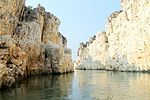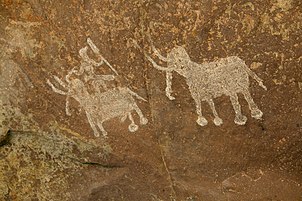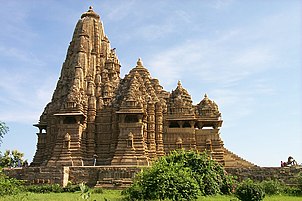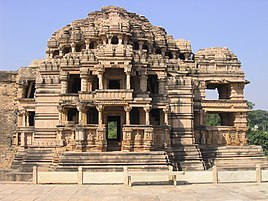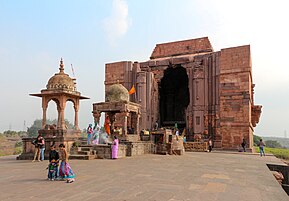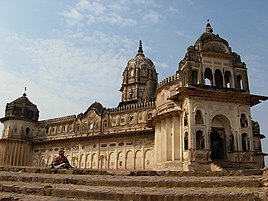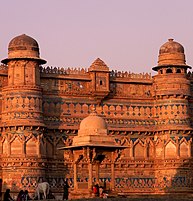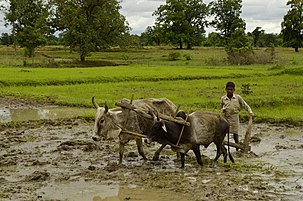
A | B | C | D | E | F | G | H | CH | I | J | K | L | M | N | O | P | Q | R | S | T | U | V | W | X | Y | Z | 0 | 1 | 2 | 3 | 4 | 5 | 6 | 7 | 8 | 9
Madhya Pradesh | |
|---|---|
| State of Madhya Pradesh | |
| Etymology: Central Province | |
| Nickname: "Heart of India" | |
| Motto: Satyameva Jayate (Truth alone triumphs) | |
| Anthem: Mera Madhya Pradesh (My Madhya Pradesh)[1] | |
 Location of Madhya Pradesh in India | |
| Country | |
| Region | Central India |
| Before was | Central Provinces and Berar |
| Formation | 26 January 1950 |
| Capital | Bhopal |
| Largest city | Indore |
| Districts | 55 (10 divisions) |
| Government | |
| • Body | Government of Madhya Pradesh |
| • Governor | Mangubhai C. Patel |
| • Chief minister | Mohan Yadav (BJP) |
| • Deputy chief minister | Jagdish Devda (BJP) Rajendra Shukla (BJP) |
| State Legislature | Unicameral |
| • Assembly | Madhya Pradesh Legislative Assembly (230 seats) |
| National Parliament | Parliament of India |
| • Rajya Sabha | 11 seats |
| • Lok Sabha | 29 seats |
| High Court | Madhya Pradesh High Court |
| Area | |
| • Total | 308,252 km2 (119,017 sq mi) |
| • Rank | 2nd |
| Dimensions | |
| • Length | 605 km (376 mi) |
| • Width | 870 km (540 mi) |
| Elevation | 400 m (1,300 ft) |
| Highest elevation | 1,352 m (4,436 ft) |
| Lowest elevation | 90 m (300 ft) |
| Population (2011)[3] | |
| • Total | |
| • Rank | 5th |
| • Density | 240/km2 (600/sq mi) |
| • Urban | 27.63% |
| • Rural | 72.37% |
| Demonym | Madhya Pradeshis |
| Language | |
| • Official | Hindi[4] |
| • Official script | Devanagari script |
| GDP | |
| • Total (2023-24) | |
| • Rank | 10th |
| • Per capita | ₹155,583.491 (US$1,864) (2023)[5] (28th) |
| Time zone | UTC+05:30 (IST) |
| ISO 3166 code | IN-MP |
| Vehicle registration | MP |
| HDI (2021) | |
| Literacy (2011) | |
| Sex ratio (2011) | 970♀/1000 ♂[8] (15th) |
| Website | mp |
| Symbols of Madhya Pradesh | |
 | |
| Song | Mera Madhya Pradesh (My Madhya Pradesh)[1] |
| Bird | Indian paradise flycatcher |
| Fish | Mahseer |
| Flower | White lily |
| Fruit | Mango |
| Mammal | Barasingha |
| Tree | Banyan Tree |
| State highway mark | |
 | |
| State highway of Madhya Pradesh MP SH1 - MP SH53 | |
| List of Indian state symbols | |
Madhya Pradesh (/ˌmɑːdjə prəˈdɛʃ/,[9] Hindi: [ˈməd̪ʱjə pɾəˈdeːʃ] ; meaning 'central province') is a state in central India. Its capital is Bhopal, and the largest city is Indore, with Gwalior, Jabalpur, Ujjain, Dewas, Sagar, and Rewa being the other major cities. Madhya Pradesh is the second largest Indian state by area and the fifth largest state by population with over 72 million residents. It borders the states of Uttar Pradesh to the northeast, Chhattisgarh to the east, Maharashtra to the south, Gujarat to the west, and Rajasthan to the northwest.[10]
The area covered by the present-day Madhya Pradesh includes the area of the ancient Avanti Mahajanapada, whose capital Ujjain (also known as Avantika) arose as a major city during the second wave of Indian urbanisation in the sixth century BCE. Subsequently, the region was ruled by the major dynasties of India. The Maratha Empire dominated the majority of the 18th century. After the Anglo-Maratha Wars in the 19th century, the region was divided into several princely states under the British and incorporated into Central Provinces and Berar and the Central India Agency. Some years after India's independence, the Central Provinces and Berar was renamed as Madhya Pradesh with Nagpur as its capital: this state included the southern parts of the present-day Madhya Pradesh and northeastern portion of today's Maharashtra. In 1956, this state was reorganised and its parts were combined with the states of Madhya Bharat, Vindhya Pradesh and Bhopal to form the new Madhya Pradesh state, the Marathi-speaking Vidarbha region was removed and merged with the Bombay State. This state was the largest in India by area until 2000, when its southeastern Chhattisgarh region was designated a separate state.
Madhya Pradesh's economy is the 10th-largest in India, with a gross state domestic product (GSDP) of ₹9.17 trillion (US$110 billion) and has the country's 26th highest per-capita income of ₹ 109372.[6] Madhya Pradesh ranks 23rd among Indian states in human development index.[11] Rich in mineral resources, Madhya Pradesh has the largest reserves of diamond and copper in India. 25.14% of its area is under forest cover.[12] Its tourism industry has seen considerable growth, with the state topping the National Tourism Awards in 2010–11.[13] In recent years, the state's GDP growth has been above the national average.[14] In 2019–20, state's GSDP was recorded at 9.07.[15]
Etymology
Madhya Pradesh means "the central province" in Hindi.
History

Isolated remains of Homo erectus found in Hathnora in the Narmada Valley indicates that Madhya Pradesh might have been inhabited in the Middle Pleistocene era.[16] Painted pottery dated to the later mesolithic period has been found in the Bhimbetka rock shelters.[17] Chalcolithic sites belonging to Kayatha culture (2100–1800 BCE) and Malwa culture (1700–1500 BCE) have been discovered in the western part of the state.[18] Madhya Pradesh is also the world's ninth-most populous subnational entity.
The city of Ujjain arose as a major centre in the region, during the second wave of Indian urbanisation in the sixth century BCE. It has served as the capital of the Avanti kingdom. Other kingdoms mentioned in ancient epics – Malava, Karusha, Dasarna and Nishada – have also been identified with parts of Madhya Pradesh.
Chandragupta Maurya conquered northern India around 320 BCE, establishing the Mauryan Empire, which included all of modern-day Madhya Pradesh. Ashoka the greatest of Mauryan rulers, conquered it, bringing the region under firmer control. After the decline of the Maurya empire, the region was contested among the Sakas, the Kushanas, the Satavahanas, and several local dynasties during the 1st to 3rd centuries CE. Heliodorus, the Greek Ambassador to the court of the Shunga King Bhagabhadra erected the Heliodorus pillar near Vidisha.
Ujjain emerged as the predominant commercial centre of western India from the first century CE, located on the trade routes between the Ganges plain and India's Arabian Sea ports. The Satavahana dynasty of the northern Deccan and the Saka dynasty of the Western Satraps fought for the control of Madhya Pradesh during the 1st to 3rd centuries CE.
The Satavahana King Gautamiputra Satakarni inflicted a crushing defeat upon the Saka rulers and conquered parts of Malwa and Gujarat in the 2nd century CE.[19]
Subsequently, the region was conquered by the Gupta empire in the 4th and 5th centuries, and their southern neighbours, the Vakataka's. The rock-cut temples at Bagh Caves in the Kukshi tehsil of the Dhar District show the presence of the Gupta dynasty in the region, supported by the testimony of a Badwani inscription dated to the year of 487 CE.[20] The attacks of the Hephthalites or White Huns brought about the collapse of the Gupta empire, which broke up into smaller states. The King Yasodharman of Malwa defeated the Huns in 528, ending their expansion. Later, Harsha (c. 590–647) ruled the northern parts of the state. Malwa was ruled by the south Indian Rashtrakuta Dynasty from the late 8th century to the 10th century.[21] When the south Indian Emperor Govinda III of the Rashtrakuta dynasty annexed Malwa, he set up the family of one of his subordinates there, who took the name of Paramara.[22]
The Medieval period saw the rise of the Rajput clans, including the Paramaras of Malwa and the Chandelas of Bundelkhand along with the Lodhis. The Chandellas built the majestic Hindu-Jain temples at Khajuraho, which represent the culmination of Hindu temple architecture in Central India. The Gurjara-Pratihara dynasty also held sway in northern and western Madhya Pradesh at this time. It also left some monuments of architectural value in Gwalior. Southern parts of Madhya Pradesh like Malwa were several times invaded by the south Indian Western Chalukya Empire which imposed its rule on the Paramara kingdom of Malwa.[23] The Paramara King Bhoja (c. 1010–1060) was claimed to be a renowned polymath. The small Gond kingdoms emerged in the Gondwana and Mahakoshal regions of the state. Northern Madhya Pradesh was conquered by the Turkic Delhi Sultanate in the 13th century. After the collapse of the Delhi Sultanate at the end of the 14th century, independent regional kingdoms re-emerged, including the Tomara kingdom of Gwalior and the Muslim Sultanate of Malwa, with its capital at Mandu.
The Malwa Sultanate was conquered by the Sultanate of Gujarat in 1531. In the 1540s, most parts of the state fell to Sher Shah Suri, and subsequently to the Hindu King Hemu. Hemu, who had earlier served as the General of the Islamic Suri dynasty, operated from the Gwalior Fort during 1553–56 and became the ruler of Delhi as a Vikramaditya king winning 22 battles continuously from Bengal to Gujrat and defeating Akbar's forces in the Battle of Delhi on 7 October 1556. However, he chose Delhi as his capital after his formal Coronation and left Gwalior. After Hemu's defeat by Akbar at the Second Battle of Panipat in 1556, most of Madhya Pradesh came under the Mughal rule. Gondwana and Mahakoshal remained under the control of Gond kings, who acknowledged Mughal suzerainty but enjoyed virtual autonomy.
The Mughal control weakened considerably after the death of Emperor Aurangzeb in 1707. Between 1720 and 1760, the Marathas conquered most of Madhya Pradesh, resulting in the establishment of semi-autonomous states under the nominal control of the Peshwa of Pune: the Holkars of Indore ruled much of Malwa, Pawars ruled Dewas and Dhar, the Bhonsles of Nagpur dominated Mahakoshal-Gondwana area, while the Scindias of Gwalior controlled the northern parts of the state. The most notable Maratha rulers of the region were Mahadji Shinde, Ahilyabai Holkar and Yashwantrao Holkar. Besides these, there were several other small states, including Bhopal, Orchha, and Rewa. The Bhopal state, which paid tribute to both the Marathas and the Nizam of Hyderabad, was founded by Dost Mohammed Khan, a former General in the Mughal army.
After the Third Anglo-Maratha War, the British conquered the entire region. All the sovereign states in the region became princely states of British India, governed by the Central India Agency. The Mahakoshal region became a British province: the Saugor and Nerbudda Territories. In 1861, the British merged the Nagpur Province with the Saugor and Nerbudda Territories to form the Central Provinces.
During the 1857 uprising, rebellions happened in the northern parts of the state, led by leaders like Tatya Tope, Rani Avantibai Lodhi. However, these were crushed by the British and the princes loyal to them. The state witnessed a number of anti-British activities and protests during the Indian independence movement.[24] Several notable leaders such as Chandra Shekhar Azad, B. R. Ambedkar, Shankar Dayal Sharma, Atal Bihari Vajpayee and Arjun Singh were born in what is now Madhya Pradesh.
After the independence of India, Madhya Pradesh was created in 1950 from the former British Central Provinces and Berar and the princely states of Makrai and Chhattisgarh, with Nagpur as the capital of the state. The new states of Madhya Bharat, Vindhya Pradesh, and Bhopal were formed out of the Central India Agency. In 1956, the states of Madhya Bharat, Vindhya Pradesh, and Bhopal were merged into Madhya Pradesh, and the Marathi-speaking southern region Vidarbha, which included Nagpur, was ceded to Bombay state. Jabalpur was chosen to be the capital of the state but at the last moment, due to political interference, Bhopal was made the state capital.[25] In November 2000, as part of the Madhya Pradesh Reorganization Act, the southeastern portion of the state split off to form the new state of Chhattisgarh.
-
Mesolithic rock painting, Bhimbetka rock shelters, a UNESCO World Heritage Site
-
Bateshwar temple complex, Padavli, Morena
-
Chausath Yogini Temple, Mitavli, Morena
-
Teli ka Mandir, Gwalior Fort
-
Shiva Temple in Bhojpur
-
Lakshmi Temple, Orchha
-
Brahma statue with various deities at Amarkantak.
-
Gwalior Fort, Gwalior
-
Gwalior Fort
-
Maa Chamunda Mata Temple, Tekri Dewas
-
Mahakaleshwar Temple Ujjain
-
Maheshwar Ghats and Fort, Maheshwar, Khargone
-
Omkareshwar Temple, Khandwa
Geography
Location in India
Madhya Pradesh literally means "Central Province", and is located in the geographic heart of India in between the latitude of 21.6°N–26.30°N and longitude of 74°9'E–82°48'E. The state straddles the Narmada River, which runs east and west between the Vindhya and Satpura ranges; these ranges and the Narmada are the traditional boundaries between the north and south of India. The highest point in Madhya Pradesh is Dhupgarh, with an elevation of 1,350 m (4,429 ft).[26]
The state is bordered on the west by Gujarat, on the northwest by Rajasthan, on the northeast by Uttar Pradesh, on the east by Chhattisgarh, and on the south by Maharashtra.

Climate
Madhya Pradesh also has three major seasons – Summer, Monsoon, and Winter. During summer (March–June), the temperature in the entire state ranges above 34.6 it has increased as it is all-time high in Madhya Pradesh. In general, the eastern parts of Madhya Pradesh are hotter than the western parts. The regions like Gwalior, Morena and Datia record temperatures of over 42 °C in May. The humidity is relatively very low and the region usually experiences frequent mild dust storms. The southwest Monsoon usually breaks out in mid-June and the entire state receives a major share of its rainfall between June and September. The south and south-east regions tend to experience a higher rainfall whereas the parts of the north-west receive less. Mandla, Balaghat, Sidhi, Jabalpur, and other extreme eastern parts receive more than 150 cm of rainfall. The districts of western Madhya Pradesh receive less than 80 cm of rainfall.[27]
The winter season starts in November. The temperature remains low in the northern parts of the state in comparison to the southern parts. The daily maximum temperature in most of the northern part of January remains between 15 and 18 °C. The climate is generally dry and pleasant with a clear sky. The average rainfall is about 1,194 mm (47.0 in). The southeastern districts have the heaviest rainfall, some places receiving as much as 2,150 mm (84.6 in), while the western and northwestern districts receive 1,000 mm (39.4 in) or less.
Ecology
According to the 2011 figures, the recorded forest area of the state is 94,689 km2 (36,560 sq mi) constituting 30.7% of the geographical area of the state.[28] It constitutes 12.3% of the forest area of India. Legally this area has been classified into "Reserved Forest" (65.3%), "Protected Forest" (32.8%) and "Unclassified Forest" (0.2%). Per capita forest area is 2,400 m2 (0.59 acres) as against the national average of 700 m2 (0.17 acres). The forest cover is less dense in the northern and western parts of the state, which contain the major urban centres. Variability in climatic and edaphic conditions brings about significant difference in the forest types of the state. In January 2019 1.5 million volunteers in the state planted 66 million trees in 12 hours along the Narmada river.[29]
The major types of soils found in the state are:
- Black soil, most predominantly in the Malwa region, Mahakoshal and in southern Bundelkhand
- Red and yellow soil, in the Baghelkhand region
- Alluvial soil, in Northern Madhya Pradesh
- Laterite soil, in highland areas
- Mixed soil, in parts of the Gwalior and Chambal divisions
Flora and fauna
Madhya Pradesh is home to ten National Parks; Bandhavgarh National Park, Kanha National Park, Satpura National Park, Sanjay National Park, Madhav National Park, Van Vihar National Park, Mandla Plant Fossils National Park, Panna National Park, Pench National Park and Dinosaur National Park, Dhar.[30][31]
There are also a number of nature reserves, including Amarkantak, Bagh Caves, Balaghat, Bori Natural Reserve, Ken Gharial, Ghatigaon, Kuno Palpur, Narwar, Chambal, Kukdeshwar, Chidi Kho, Nora Dehi, Pachmarhi, Panpatha, Shikarganj, Patalkot, and Tamia. Pachmarhi Biosphere Reserve in Satpura Range, Amarkantak biosphere reserve and Panna National Park are three of the 18 biosphere reserves in India. Most of them are located in eastern Madhya Pradesh near Jabalpur.
-
Langur monkey (Semnopithecus dussumieri), Orchha
-
Tigress with cubs in Kanha Tiger Reserve
-
Tickell's blue flycatcher, Bandhavgarh National Park
-
Vultures in the nest, Orchha
-
Male nilgais fighting, Lakeshwari, Gwalior district
Kanha, Bandhavgarh, Pench, Panna, and Satpura National Parks are managed as Project Tiger areas. The National Chambal Sanctuary is managed for conservation of gharial and mugger, river dolphin, smooth-coated otter and a number of turtle species. Ken-gharial and Son-gharial sanctuaries are managed for conservation of gharial and mugger. The barasingha is the state animal and the dudhraj is the state bird of Madhya Pradesh.
Based on composition, the teak and sal forests are the important forest formations in the state. Bamboo-bearing areas are widely distributed.
State symbols of Madhya Pradesh
| Title | Symbol | Image |
|---|---|---|
| State animal | Barasingha[32][33] (Rucervus duvaucelii) | 
|
| State bird | Indian paradise flycatcher (Terpsiphone paradisi)[34] | 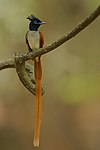
|
| State tree | banyan tree (ficus bengalensis)[35] | 
|
| State fish | Mahasheer (Tor tor)[34] | 
|
| State Flower | Madonna lily (Lilium candidum)[36] | 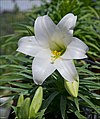
|
Rivers
-
Narmada River
-
Son River, Umaria district, MP, India
-
The River Narmada flows through a gorge of marble rocks in Bhedaghat, Jabalpur
-
The Shri Ram Ghat on the Shipra River in Ujjain
-
Betwa in the Ashoknagar District of Madhya Pradesh
The Narmada is the longest river in Madhya Pradesh. It flows westward through a rift valley, with the Vindhya ranges sprawling along its northern bank and the Satpura range of mountains along the southern. Its tributaries include the Banjar, the Tawa, the Machna, the Shakkar, the Denwa and the Sonbhadra rivers. The Tapti River runs parallel to Narmada, and also flows through a rift valley. The Narmada–Tapti systems carry an enormous volume of water and provide drainage for almost a quarter of the land area of Madhya Pradesh. The Narmada river is considered very sacred and is worshipped throughout the region. It is the main source of water and acts as a lifeline to the state.
The Vindhyas form the southern boundary of the Ganges basin, with the western part of the Ganges basin draining into the Yamuna and the eastern part directly into the Ganges itself. All the rivers, which drain into the Ganges, flow from south to north, with the Chambal, Shipra, Kali Sindh, Parbati, Kuno, Sind, Betwa, Dhasan, Ken and Sunarrivers being the main tributaries of the Yamuna. Shipra River is one of the most sacred rivers of Hinduism. It is the site of the Simhastha Kumbh Mela, which is held every 12 years. Shipra is stretched across Indore, Ujjain and Dewas. The land drained by these rivers is agriculturally rich, with the natural vegetation largely consisting of grass and dry deciduous forest types, largely thorny. The eastern part of the Ganges basin consists of the Son, the Tons and the Rihand Rivers. Son, which arises in the Maikal hills around Amarkantak, is the largest tributary that goes into the Ganges on the south bank and that does not arise from the Himalayas. Son and its tributaries contribute the bulk of the monsoon flow into the Ganges, because the north bank tributaries are all snow fed. The forests in their basins are much richer than the thorn forests of the northwestern part of Madhya Pradesh.
After the formation of Chhattisgarh State, the major portion of Mahanadi basin now lies in Chhattisgarh. Presently, only 154 km2 basin area of Hasdeo River in Anuppur District lies in Madhya Pradesh.
The Satpuras, in the Gawilgarh and Mahadeo Hills, also contain a watershed, which is south facing. The Wainganga, the Wardha, the Pench, the Kanhan rivers, discharge an enormous volume of water into the Godavari river system. The Godavari basin consists of sub-tropical, semi-moist forests, mainly in the valley of the Indrawati. There are many important multi-state irrigation projects in development, including the Godavari River Basin Irrigation Projects.
Regions
Madhya Pradesh is divided into the following agro-climatic zones:
Administration
Madhya Pradesh is divided into 55 districts for administrative purposes. The district is the main unit of administration. These districts are arranged in 10 divisions, listed below:[37]
Cities
| Rank | Name | District | Pop. | ||||||
|---|---|---|---|---|---|---|---|---|---|
 Indore  Bhopal |
1 | Indore | Indore | 2,167,447 |  Jabalpur  Gwalior | ||||
| 2 | Bhopal | Bhopal | 1,883,381 | ||||||
| 3 | Jabalpur | Jabalpur | 1,267,564 | ||||||
| 4 | Gwalior | Gwalior | 1,101,981 | ||||||
| 5 | Ujjain | Ujjain | 593,368 | ||||||
| 6 | Sagar | Sagar | 370,296 | ||||||
| 7 | Dewas | Dewas | 289,438 | ||||||
| 8 | Satna | Satna | 283,004 | ||||||
| 9 | Ratlam | Ratlam | 273,892 | ||||||
| 10 | Rewa | Rewa | 235,422 | ||||||
Demographics
Population
| Year | Pop. | ±% |
|---|---|---|
| 1951 | 18,615,000 | — |
| 1961 | 23,218,000 | +24.7% |
| 1971 | 30,017,000 | +29.3% |
| 1981 | 38,169,000 | +27.2% |
| 1991 | 48,566,000 | +27.2% |
| 2001 | 60,348,000 | +24.3% |
| 2011 | 72,597,565 | +20.3% |
| Source: Census of India[39] | ||
The population of Madhya Pradesh consists of a number of ethnic groups and tribes, castes and communities. The scheduled castes and the scheduled tribes constitute a significant portion of the population of the State 15.6% and 21.1% respectively.
The main tribal groups in Madhya Pradesh are Gond, Bhil, Baiga, Korku, Bhadia (or Bhariya), Halba, Kaul, Mariya, Malto and Sahariya. Mandla, Dhar, Dindori, Barwani, Jhabua and Alirajpur districts have more than 50% tribal population, with Jhabua and Alirajpur having nearly 90% tribal population. In Khargone, Khandwa, Burhanpur, Betul, Chhindwara, Seoni, Anuppur, Umaria, Shahdol and Singrauli districts 30–50% of the population is tribal. According to the 2011 census, the tribal population in Madhya Pradesh was 15.34 million, constituting 21.1% of the total population. There were 46 recognised Scheduled Tribes and three of them have been identified as "Special Primitive Tribal Groups" in the State.[40]
Madhya Pradesh ranks(33rd) on the Human Development Index value of 0.606 (2018).[41] According to the SDG India Index 2020–21 compiled by the NITI AAYOG, Madhya pradesh ranks 21 on sustainable development goals. The state's per-capita gross state domestic product (nominal GDP) is the 26th in the country (2018–19).[42] According to NITI Aayog SDGs India index the state ranks 9th on gender equality, 10th on clean water and sanitation.[43]
-
Children in Raisen district, Bhil tribe
-
Shepherds in Chambal
-
A young farmer in Umaria district
-
Young Baiga women
Languages
The official language of the state is Hindi, which is spoken by over two-thirds of the population and is used for all government business.[4] In urban areas Standard Hindi is the main language, while Urdu is spoken by Muslims. In rural areas, however, most speak varieties counted as dialects of Hindi in the census, although most are quite distinct. In the west are Malvi and Nimadi in the Malwa and Nimar regions, which are more closely related to the Rajasthani languages. In Bundelkhand in the north and Baghelkhand in the east are spoken Bundeli and Bagheli which are eastern varieties of the Hindi languages, similar to Awadhi or Chhattisgarhi. In the southeast is spoken Chhattisgarhi and Powari is the language of the far south, both Eastern Hindi languages. Most speakers of these languages consider them to be dialects of Hindi and so report their language as 'Hindi' on the census.[44]
Marathi is another significant language. Due to Maratha rule over much of what is now Madhya Pradesh, Madhya Pradesh is home to the largest number of Marathis outside Maharashtra. Although large numbers of Marathis can be found in urban centres like Indore, the highest concentrations are in the southern areas of the state adjoining Maharashtra. Marathi is the most-spoken language in Burhanpur district, while it is a major minority language in the southern parts of Mahakoshal especially Betul, Chhindwara and Balaghat districts.[44]
There are several languages spoken by the Adivasis. The various Bhil languages are Indo-Aryan languages spoken by 50 lakh Bhils of western Madhya Pradesh. Although many, especially in the eastern parts of their range, have adopted the regional languages as mother tongue, the languages are still strong in the far-western hills especially Barwani, Jhabua and Alirajpur districts where they are in the majority. Bhili, the Bareli languages and Bhilali are the major varieties spoken in the state.
Gondi is the second-largest Adivasi language, spoken by 11 lakh Gonds in the state. A Dravidian language related to Telugu, it is mainly spoken in the southern Satpura highlands of Mahakoshal, where it is spoken with the regional languages. Some in the more remote valleys of the Satpuras speak a poorly-described Dravidian dialect called Bharia. Smaller minorities of Gondi speakers can be found in Khandwa and Dewas districts in the west as well as Anuppur, Sidhi and Singrauli districts in the east. Elsewhere in the state, the Gonds have almost totally abandoned their original language.
Korku, a Munda language, has over 400,000 speakers in the central highlands of the state. In the far-southeast of Burhanpur can be found some speakers of the language isolate Nihali who live among the Korku. All speakers of tribal languages face significant pressure to switch to the dominant regional languages while their own tongues are considered 'backward' and 'rural'.[44]
The following languages are taught in schools in Madhya Pradesh under the Three Language Formula:[45]
First language: Any Scheduled Language
Zdroj:https://en.wikipedia.org?pojem=Madhya_Pradesh,_India
Text je dostupný za podmienok Creative Commons Attribution/Share-Alike License 3.0 Unported; prípadne za ďalších podmienok. Podrobnejšie informácie nájdete na stránke Podmienky použitia.
Antropológia
Aplikované vedy
Bibliometria
Dejiny vedy
Encyklopédie
Filozofia vedy
Forenzné vedy
Humanitné vedy
Knižničná veda
Kryogenika
Kryptológia
Kulturológia
Literárna veda
Medzidisciplinárne oblasti
Metódy kvantitatívnej analýzy
Metavedy
Metodika
Text je dostupný za podmienok Creative
Commons Attribution/Share-Alike License 3.0 Unported; prípadne za ďalších
podmienok.
Podrobnejšie informácie nájdete na stránke Podmienky
použitia.
www.astronomia.sk | www.biologia.sk | www.botanika.sk | www.dejiny.sk | www.economy.sk | www.elektrotechnika.sk | www.estetika.sk | www.farmakologia.sk | www.filozofia.sk | Fyzika | www.futurologia.sk | www.genetika.sk | www.chemia.sk | www.lingvistika.sk | www.politologia.sk | www.psychologia.sk | www.sexuologia.sk | www.sociologia.sk | www.veda.sk I www.zoologia.sk




